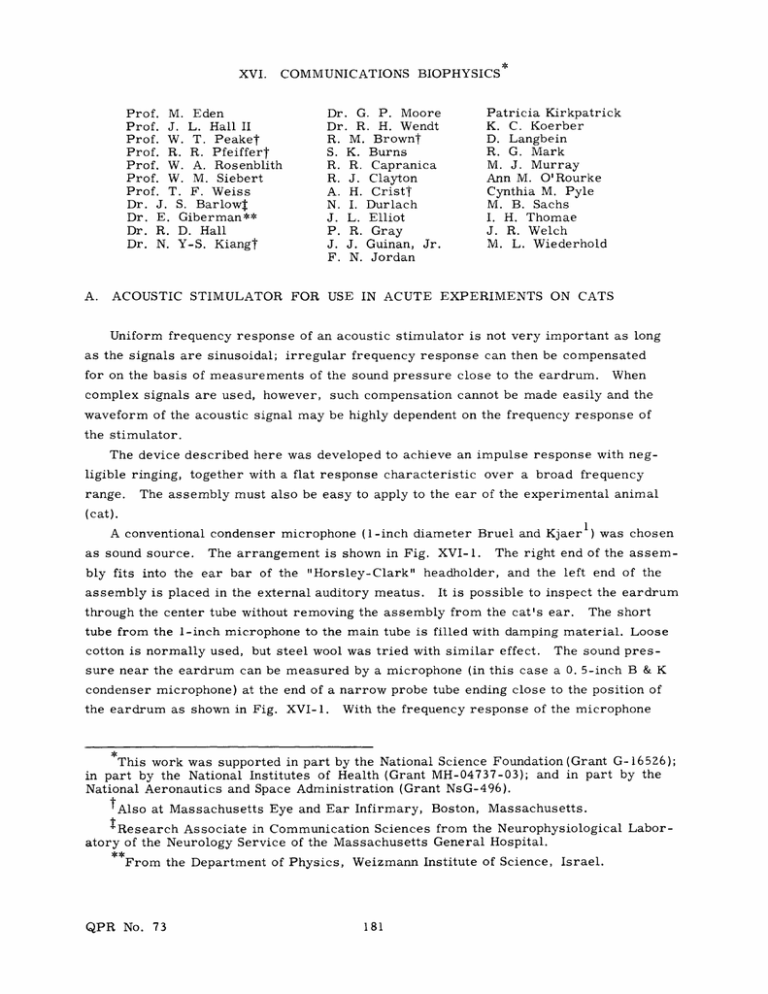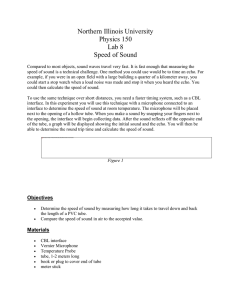XVI. COMMUNICATIONS BIOPHYSICS Prof. M. Eden
advertisement

XVI. COMMUNICATIONS BIOPHYSICS Prof. M. Eden Prof. J. L. Hall II Prof. W. T. Peaket Prof. R. R. Pfeiffert Prof. W. A. Rosenblith Prof. W. M. Siebert Prof. T. F. Weiss Dr. J. S. Barlow$ Dr. E. Giberman** Dr. R. D. Hall Dr. N. Y-S. Kiangf A. Dr. G. P. Moore Dr. R. H. Wendt R. M. Brownt S. K. Burns R. R. Capranica R. J. Clayton A. H. Cristl N. I. Durlach J. L. Elliot P. R. Gray J. J. Guinan, Jr. F. N. Jordan Patricia Kirkpatrick K. C. Koerber D. Langbein R. G. Mark M. J. Murray Ann M. O'Rourke Cynthia M. Pyle M. B. Sachs I. H. Thomae J. R. Welch M. L. Wiederhold ACOUSTIC STIMULATOR FOR USE IN ACUTE EXPERIMENTS ON CATS Uniform frequency response of an acoustic stimulator is not very important as long as the signals are sinusoidal; irregular frequency response can then be compensated for on the basis of measurements of the sound pressure close to the eardrum. complex signals are used, however, When such compensation cannot be made easily and the waveform of the acoustic signal may be highly dependent on the frequency response of the stimulator. The device described here was developed to achieve an impulse response with negligible ringing, together with a flat response characteristic range. over a broad frequency The assembly must also be easy to apply to the ear of the experimental animal (cat). A conventional condenser microphone (1-inch diameter Bruel and Kjaer ) was chosen as sound source. The arrangement is shown in Fig. XVI-1. The right end of the assem- bly fits into the ear bar of the "Horsley-Clark" headholder, assembly is placed in the external auditory meatus. and the left end of the It is possible to inspect the eardrum through the center tube without removing the assembly from the cat's ear. The short tube from the 1-inch microphone to the main tube is filled with damping material. Loose cotton is normally used, but steel wool was tried with similar effect. The sound pres- sure near the eardrum can be measured by a microphone (in this case a 0. 5-inch B & K condenser microphone) at the end of a narrow probe tube ending close to the position of the eardrum as shown in Fig. XVI-1. With the frequency response of the microphone ,This work was supported in part by the National Science Foundation (Grant G-165Z6); in part by the National Institutes of Health (Grant MH-04737-03); and in part by the National Aeronautics and Space Administration (Grant NsG-496). Also at Massachusetts Eye and Ear Infirmary, Boston, Massachusetts. lResearch Associate in Communication Sciences from the Neurophysiological Laboratory of the Neurology Service of the Massachusetts General Hospital. From the Department of Physics, Weizmann Institute of Science, Israel. QPR No. 73 181 19 2 6 35 88K MICROPHONE 4134 ALL 19 Fig. XVI-1. kENSK)NSINMLUN*TERS Arrangement of the stimulator. -30. 0.1 FREQUENCY (KCPS) Fig. XVI-2. QPR No. 73 Characteristic of the probe tube with and without a washer, which decreases the air volume in front of the diaphragm. The microphone was a B & K type 4134 (0. 5-inch diameter). 182 (XVI. COMMUNICATIONS BIOPHYSICS) and probe tube known, the sound-pressure level at the tip of the probe tube can be calculated from the measured output of the microphone. The frequency characteristic of the microphone and probe tube is shown in Fig. XVI-2. The characteristic, for this configuration, is far from uniform. By appropriate damping of this probe tube with steel wool it is possible to get almost flat response up to a certain frequency and, above this, a response that declines with almost constant slope. The device is used in acute experiments, however, in which the probe may become filled with blood, which is difficult to remove from the steel wool without changing the characteristic. Hence, calibration of the probe microphone would be necessary before each experiment. An undamped probe tube can be cleaned easily without changing its characteristic. The drawback to the use of an undamped probe is the nonuniform calibration. Fig. XVI-3. Impulse response of the assembly shown in Fig. XVI-1 equipped with a dynamic earphone (selected Permaflux PDR-10 with better impulse response than that of an average earphone) compared with (right) a condenser microphone (B & K 4131) used as sound source. In both cases the electrical input to the earphones was a 50-psec rectangular pulse. Figure XVI-3 shows the impulse response of the assembly with a dynamic earphone as sound source (left) and with a condenser microphone as sound source (right). The responses were measured in a 0. 6-cc rigid cavity connected to the assembly in the place of an ear. The bottom of the 0.6-cc cavity was a 1-inch condenser microphone (B & K 4131). The sound pressure was measured with that microphone. When the assemterminated with the ear of a cat it is not possible to measure the sound output in the same way as for the case in which the assembly is terminated with a rigid cavity. The probe microphone is not suitable for measuring the impulse response because of the distortion introduced by the probe tube. It is bly is Fig. XVI-3 that the impulse response of the assembly with a condenser sound source (right) is narrower than it is if the sound source is a dynamic seen from earphone. QPR No. 73 183 20- 500( 0 -3 10 95 Fig. XVI-4. B 8 K I' MICROPHONE AS SOURCE,MEASURE IN A 12CC COUPLER (WITH A 1/2' B8 K MIKE 90 I o - -10 Second-harmonic content in the sound output of a condenser earphone (B & K 4131). The measurements were performed in a 1. 2-cc rigid cavity with a B & K condenser microphone type 4134 at 1000 cps. S95 -j -2 D8 INPUT RE31V RMS DBSPL 0 85 804 S7570 SOUND MEASUI TO THE IN ACA S65. 60- o 55S B8 K + COUPLER O 50 = / FREQUENCY Fig. XVI-5. QPR No. 73 + TUBE 45 (KCPS) Frequency response of the stimulus device. Solid circles indicate measurements performed with the B & K microphone (1 inch) as sound source and measured with a 0. 5inch microphone in a 1. 2-cc cavity. The open circles show the response of the same transducer in connection with the tube (Fig. XVI-1) measured in a 1.2-cc cavity; the triangles show the response of the same system when connected to the ear of a cat and measured at the end of the tube. The electrical input to the condenser earphone is constant throughout. 184 (XVI. 1. COMMUNICATIONS BIOPHYSICS) Linearity Distortion is introduced in the output of a condenser microphone used as a sound source when the movement of the diaphragm is an appreciable fraction of the distance o K 295 - K 292 *K 290 95- 85 .z 80 75 0 P 70 gL)65 o - 60 10 0551 50 FREQUENCY (KCPS) Fig. XVI-6. Sound pressure measured close to the eardrum of three different cats with the stimulator equipped with a B & K condenser microphone (4131) as sound source with constant electrical input. between the diaphragm and the stationary electrode. Figure XVI-4 shows the contents of the second-harmonic sound-pressure level (SPL) for different polarization voltages. The sound pressure was measured in a rigid cavity with a volume of 1. 2 cc. It is seen that it is possible to obtain a level of 105 db SPL with approximately 3 per cent distortion. Figure XVI-5 shows the frequency response of the stimulus devices measured in different ways. The response of the stimulator system is much better when applied to an ear (triangles) than when connected to a rigid cavity (solid circles). The peak in the response near 20 kc,2 which is most pronounced in the response measured in a rigid cavity, is a transverse resonance in the measuring cavity. The cavity in front of the condenser earphone (see Fig. XVI-1) has the same diameter as the measuring cavity. Therefore, a similar peak, although not as pronounced, is seen in the sound pressure measured near the eardrum of a cat. Figure XVI-6 shows the response of the assembly measured close to the eardrum on three different cats. A. R. M0ller (Mr. Aage R. MOller is now at the Fysiologiska Institutionen, Karolinska Institutet, Stockholm. Mr. MOller visited this laboratory from September to December 1961, during which time he carried out the work reported here in cooperation with the staff of the Eaton-Peabody Laboratory, Massachusetts Eye and Ear Infirmary, Boston.) QPR No. 73 185 (XVI. COMMUNICATIONS BIOPHYSICS) References 1. Bruel and Kjaer Instruments Inc., 3044 West 106 Street, Cleveland 11, Ohio, hereafter referred to as B & K. 2. The measuring cavity is cylindrical and the diameter is 1.7 cm. The measured peak appears at 21. 5 kc and the calculated natural frequency is 22. 7 kc (see P. M. Morse, Vibration and Sound (McGraw-Hill Book Company, Inc., New York, 2d edition, 1948), p. 398.) B. BINAURAL UNMASKING AND "ECHOLOCATION" In recent months, new projects have been initiated in two areas of hearing that were not included in our Research Objectives given in Quarterly Progress Report No. 72 (pages 223-224): (1) psychoacoustics of binaural unmasking and (2) "echolocation" The work in both these areas constitutes a continuation of previous work at Lincoln Laboratory, M. I. T. 3 behavior.2 In the area of binaural unmasking, experiments have been started on the following topics: localization in the presence of masking noise; binaural unmasking as a function of the angular dispersion of the masking noise; time-intensity trading with a detection criterion; binaural unmasking as a function of interaural phase shifts in the masking noise; binaural unmasking as a function of interaural time delays in the masking noise; adaptation to magnified interaural time delays. Also, a mathematical model has been constructed for describing the data on binaural unmasking at high frequencies.4 In the area of echolocation, work has been continued in collaboration with F. A. Webster on the ability of the bat Myotis lucifugus to discriminate between targets of various shapes. Also, new experiments have been started on the ability of Myotis to detect targets in a background of clutter and on the ability of humans to echolocate with the aid of artificial sonic generators. The work in both of these areas will be reported on when results are available. N. I. Durlach References 1. The phrase "binaural unmasking" refers to the advantages of two ears over one ear with respect to the detection of a signal in a background of interference. 2. The term "echolocation" is the biologist's equivalent of the term "sonar." For a summary of all but the most recent work on echolocation, see D. R. Griffin, Listening in the Dark (Yale University Press, New Haven, Conn., 1958). 3. N. I. Durlach, Note on the creation of pitch through binaural interaction, J. Acoust. Soc. Am. 34, 1096-1099 (1962); N. I. Durlach, Equalization and cancellation theory of binaural masking level differences, J. Acoust. Soc. Am. 35, 1206-1218 (1963); F. A. Webster and N. I. Durlach, Echolocation Systems of the Bat; Progress Report on Experimental Studies Conducted at F. A. Webster's Laboratory (1 November 19611 September 1962), Report No. 41G-3, Lincoln Laboratory, M. I. T., 14 August 1963. QPR No. 73 186 (XVI. J. COMMUNICATIONS BIOPHYSICS) 4. N. I. Durlach, Note on binaural masking-level differences at high frequencies, Acoust. Soc. Am. (in press). QPR No. 73 187



